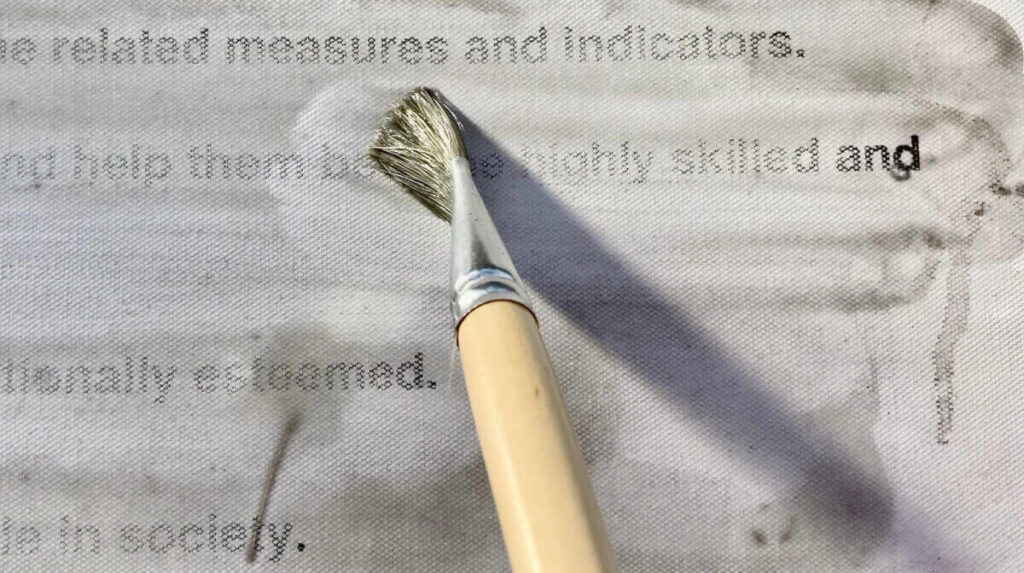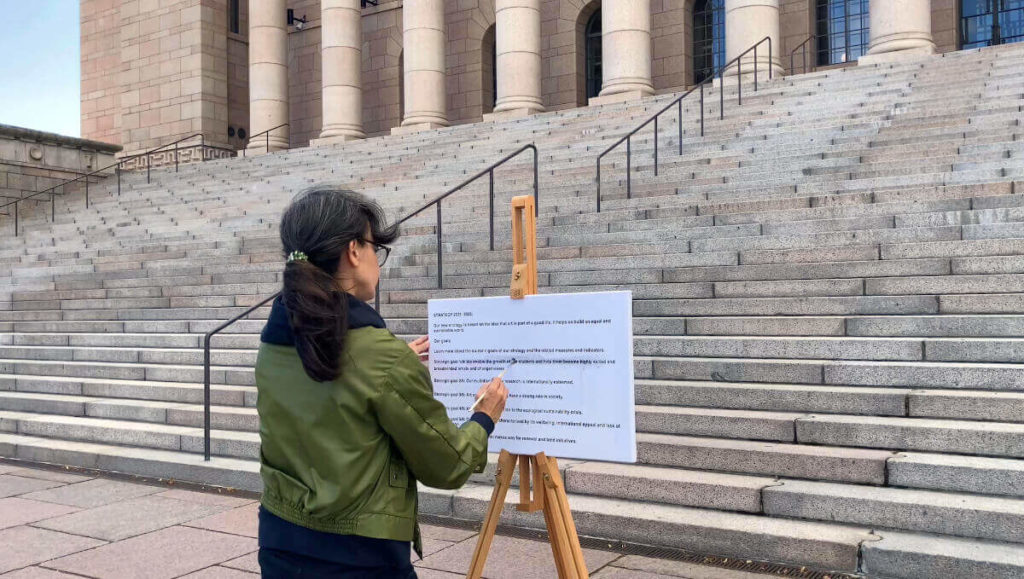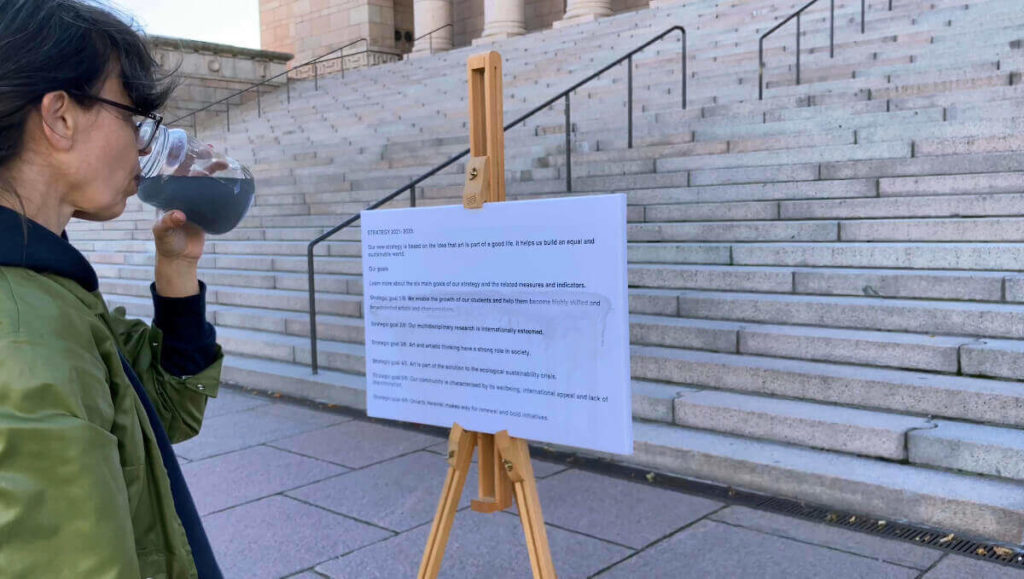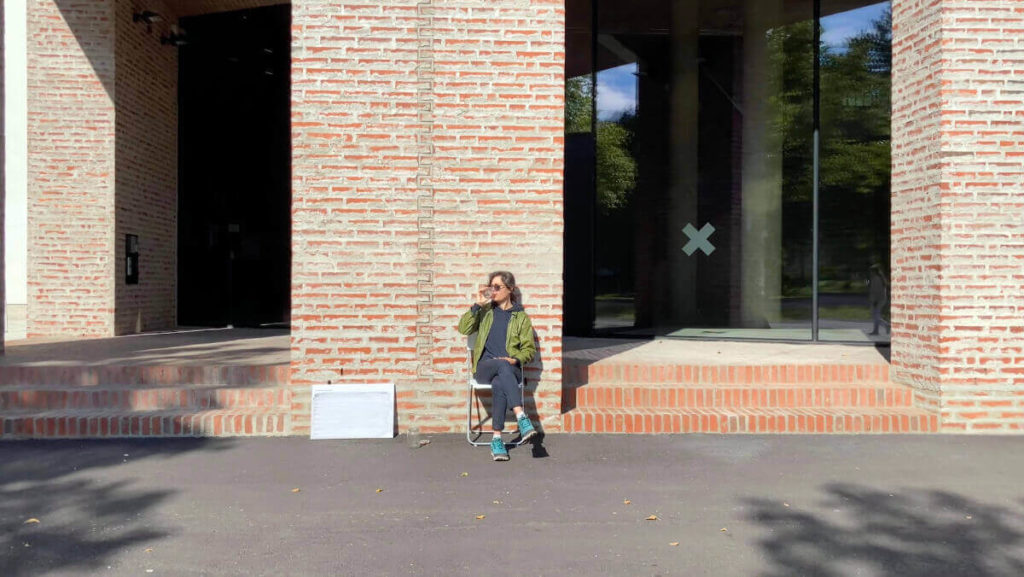Internalizing the strategy
The video performance “Internalizing the Strategy” was presented the first time in this format at the CARPA7 conference on August 27, 2021. The work addresses the problematic nature of internalizing the strategy text at the University of the Arts Helsinki, and more broadly, the challenges of university policy in Finland, which manifest themselves as a restriction of scientific and artistic freedom and are reflected in the ethos of modern university politics, especially the tendency to create economic value for creativity. In performance, the internalization of strategy occurs through material, pictorial, verbal and bodily action. What is said in the strategy text combines the paradox of the verbalization of art and requires a reworking of the matter through performance.

Introduction
My research interest is currently to challenge the binary essence of the photograph by destabilizing it with image-based experiments at the public places. In these situations, the image is slowly and manually removed, highlighting the physical connection to the digital image. The chosen image and its location are often based on existing structures, formats and established procedures.
“Off painting” is a method of artistic research in progress, where a digital photograph is printed on a canvas base in the likeness of a painting. Work is done by hand with the help of water and brush; thus, the idea of painting is inversely emphasized. The method is usually practiced in the place where the picture was taken. An exception to that is the video performance discussed here, where the image is the image of the text as a physical object.
In performance, the attempt to internalize strategy takes place by a pictorial and bodily act that emphasizes the absurd nature of the objectives and requirements contained in the strategy text in relation to the self-value of art.

In Finland, free academic research is the subject of strategic emphasis and requirements placed in universities by the Ministry of Education and Culture. If the research topic does not fit into a specific frame of reference according to the strategy, the existence of research funding and free research is seriously threatened. At the University of the Arts, academic and artistic freedom is not threatened in every aspect of the strategy, and not all the effects of implementing the strategy are negative. That is precisely why I want to focus my attention on words whose meaning remains partially obscure and, in all its positivity, gives an indication of the continuation of the demands from the outside.
The strategy, as a means of an objective truth, requires subjective affirmation to become truth to us, and it is impossible to get rid of uncertainty other than through faith. Through performative act, it becomes apparent how “strategical truth” becomes humanly significant when researcher is in an internal relation to it. When we are in a passionate, inner relationship to paradox, it is a matter of faith.
Uniarts Helsinki’s strategy
You can read the same content in an accessible format on the website Strategy 2021–2030.
Strategic goal 1/6: We enable the growth of our students and help them become highly skilled and broadminded artists and changemakers.
Strategic goal 2/6: Our multidisciplinary research is internationally esteemed.
Strategic goal 3/6: Art and artistic thinking have a strong role in society.
Strategic goal 4/6: Art is part of the solution to the ecological sustainability crisis.
Strategic goal 5/6: Our community is characterised by its wellbeing, international appeal and lack of discrimination.
Strategic goal 6/6: Uniarts Helsinki makes way for renewal and bold initiatives.
Video performance
Un-said
Expert language is often intended to make certain choices feel necessary and useful. A certain demand and promise of progress have been embedded in this language, and it is hard to resist. However, it also opens the possibility of using its vocabulary in many ways, like to approach expert language through the image, speech and absence.
My question here is: How can the material removal of text through an image and its transformation into speech, help to transform externally given textual content into an internal experience? Can the experience thus gained expand the understanding about the relationship between the inner and outer worlds through presentation?
In the book Infancy & History Essays on the Destruction of Experience Giorgio Agamben states, that ineffable, the un-said, are categories which belong exclusively to human language (Agamben 1993, 4). Far from indicating a limit of language, they express its power of the presupposition, the unsayable being precisely what language must presuppose in order to signify (Ibid).
In relation to this, a little later he quotes Ludwig Wittgenstein (1889–1951), whose only public lecture explains the experience of the language (experimentum linguae) as follows:
‘And now I shall describe the experience of wonderment before the existence of the world, with these words: the world thus is experienced as a miracle. I am now tempted to say that the correct expression in language for the miracle of the existence of the world, albeit as expressing nothing within language, is the existence of language itself.’
Agamben presents Wittgenstein’s idea while continuing to give his reader a question: “If the most appropriate expression of wonder about the existence of the world is the existence of language, then what is the correct expression for the existence of language?” The only possible answer to this question he gives human life, like ethos, the ethical way, the search for a polis. (Agamben 1993, 9, 10)
The idea of Wittgenstein raised by Agamben, position expert language and strategy text into a wider perspective. Academic and artistic work and solving the related problem requires the mastery of entities, scientific curiosity, and multidisciplinary nature. Curiosity, heresy and failures are essential, especially from the perspective of developing artistic research. It cannot be fully controlled but arise as a result of events that are instantaneous and difficult to foresee. Science and university history shows that academic freedom is a key prerequisite for the development of science.
For artistic research, that is a decisive factor. Top-down profiling contrasts with the ethos of science and, for example, scientific curiosity or criticality. Profiling and concentrating resources inevitably mean diminishing diversity.

Conclusion, remarks
Our ways of obtaining information through various modelling (including strategies) may carry epistemic burdens that very tangibly organize political ecologies even more hierarchical. Legitimizing certain types of expert knowledge at the expense of others and the indistinguishable relationships between recognized knowledge and management practices are visible examples of such burdens. “Expert knowledge” can be traced by studying strategy vocabulary, how it corresponds to the actual situation. Video Performance Internalizing Strategy is looking for its way of slowing down and linger near the strategy. University strategy text requires concrete, physical and local reading.

References
Agamben, Giorgio. 1993. Infancy and History. On the Destruction of Experience. Translated by Liz Heron. London: Verso. (First published as Infanzia e storia in 1978).
Performances
Seppälä, Mia. 2021. Internalizing the strategy. Performer: Mia Seppälä. Performance on August 13, 2021. Parliament House and Academy of Fine Arts. Presented as a video performance at the CARPA7 conference on August 27, 2021.
Performance Documentations
Seppälä, Mia. 2021. Internalizing the Strategy. HD video, duration: 14:45. https://youtu.be/CyifMZesHUs.
Internet sources
Uniarts Helsinki. “Uniarts Helsinki’s strategy 2021–2030.” Accessed October 2021. https://www.uniarts.fi/uploads/2021/10/6ce48050-uniarts-helsinki-strategy-2021-2030.pdf.
Contributor
Mia Seppälä
Mia Seppälä is an artist, researcher and teacher at The Finnish Academy of Fine Arts, University of the Arts Helsinki. Her research interests and artworks are related to photography, performance and demonstration as research, site-specificity and the environment by means of participatory art, video, performance and environmental art. She is educated as Master of Fine Arts from the Finnish Academy of Fine Arts 2017.